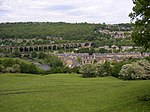The Crossley Heath School
1985 establishments in EnglandAcademies in CalderdaleAll pages needing cleanupEducational institutions established in 1985Grammar schools in Calderdale ... and 4 more
People educated at The Crossley Heath SchoolSchools in Halifax, West YorkshireSchools with a royal charterUse British English from September 2019

The Crossley Heath School is an 11–18 mixed, grammar school and sixth form with academy status in Halifax, West Yorkshire, England. It was established in 1985 following the amalgamation of Heath Grammar School and Crossley and Porter School. It is part of The Crossley Heath School Academy Trust Limited.
Excerpt from the Wikipedia article The Crossley Heath School (License: CC BY-SA 3.0, Authors, Images).The Crossley Heath School
Savile Park, Calderdale Savile Park
Geographical coordinates (GPS) Address Phone number Website External links Nearby Places Show on map
Geographical coordinates (GPS)
| Latitude | Longitude |
|---|---|
| N 53.7116 ° | E -1.878 ° |
Address
Crossley Heath Grammar School
Savile Park
HX3 0HG Calderdale, Savile Park
England, United Kingdom
Open on Google Maps










